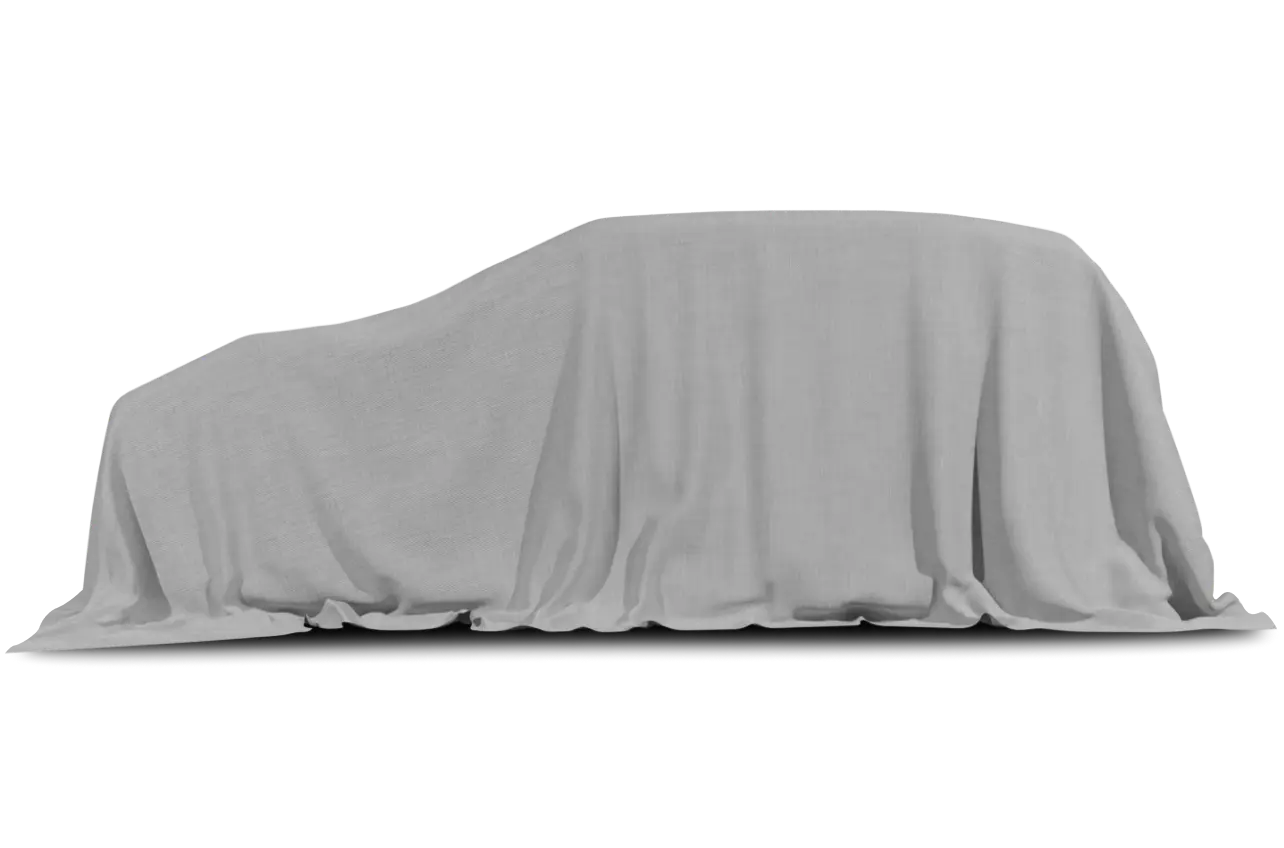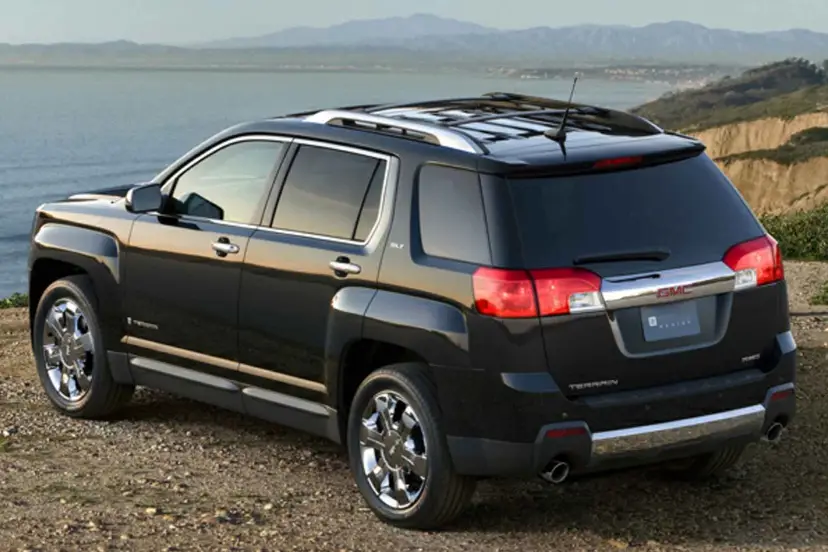
Editor’s note: This review was written in October 2009 about the 2010 GMC Terrain. Little of substance has changed with this year’s model. To see what’s new for 2011, click here, or check out a side-by-side comparison of the two model years.
It should come as little surprise that the new GMC Terrain, a corporate twin to the redesigned Chevrolet Equinox, retains most of its sibling’s strengths and weaknesses. The wild card — or, more appropriately, the elephant in the design studio — is the Terrain’s styling. If it works for you, the Terrain is every bit as competitive as the Equinox. One caveat, however: Unless you need the towing capacity, avoid the V-6. The Terrain shows its best colors in four-cylinder form.
In ascending order, trim levels are the SLE1, SLE2, SLT1 and SLT2. All four come standard with the four-cylinder engine and front-wheel drive. All-wheel drive is optional on any trim, and the V-6 is optional on all but the SLE1. On each trim, you get a little added content if you choose the GMC version versus the Chevy, which accounts for the Terrain’s higher price. I drove a front-wheel-drive V-6 SLT1, though I’ve driven both engines in the mechanically identical Equinox, which you can compare to the Terrain here.
Going & Stopping
Having driven both the four-cylinder and V-6 Equinox, I can attest that the difference in power isn’t appreciable unless you’re pushing the car hard or carrying a load of people. My V-6 Terrain drove the point home: With 264 horsepower on tap — and no all-wheel drive to weigh things down — I’d expect a bit more oomph, especially given that competitors like the V-6 Toyota RAV4 feel downright fleet-footed. The Terrain does, however, weigh a few hundred pounds more, and so it lumbers along at a more leisurely pace.
That lumbering can be an issue. A six-speed automatic is standard, but it isn’t exactly the paragon of responsiveness. Kickdown takes too long at any speed, and it’s often accompanied by uncertain gear hunting. I also noticed a vexing case of accelerator lag. It has a way of creeping up on you: Acceleration from stoplights was acceptable, but when driving around 30-40 mph it occasionally took a full second for the Terrain to respond to my right foot. I’d invariably respond by stabbing the gas pedal harder, and when the cavalry finally arrived I’d get overkill.
If anything, the 182-hp four-cylinder should have enough power for most drivers. I didn’t detect any of the V-6’s accelerator lag in the four-cylinder Equinox I tested, and the pedal felt tuned for quicker response. Overly responsive accelerators are an old trick for a lot of four-cylinder cars — and a short-lived one, when you need sustained power up an on-ramp — but I never found the base Equinox gutless. The same should be true of its GMC sibling.
GMC and Chevrolet have Toyota — and everyone else, for that matter — beat in four-cylinder gas mileage. With an impressive 22/32 mpg city/highway with the four-cylinder and front-wheel drive, the Terrain beats all competitors with similar configurations. Adding all-wheel drive or the V-6 knocks mileage down quite a bit; at that point, the Terrain ranks midpack.
| Gas Mileage (combined city/highway, mpg) | ||||||||||||||||||||
|---|---|---|---|---|---|---|---|---|---|---|---|---|---|---|---|---|---|---|---|---|
| All-wheel drive | Front-wheel drive | |||||||||||||||||||
| 2010 Toyota RAV4 | 21 – 24 | 22 – 24 | ||||||||||||||||||
| 2010 Honda CR-V | 23 | 24 | ||||||||||||||||||
| 2010 Nissan Rogue | 23 | 24 | ||||||||||||||||||
| 2010 GMC Terrain | 20 – 23 | 20 – 26 | ||||||||||||||||||
| 2009 Subaru Forester* | 21 – 22 | — | ||||||||||||||||||
| 2010 Ford Escape | 20 – 22 | 21 – 24 | ||||||||||||||||||
| 2009 Hyundai Santa Fe | 19 | 20 | ||||||||||||||||||
| *Forester with turbo engine requires premium fuel. All others use regular. Source: EPA data; variances are due to various transmissions and engines offered. |
||||||||||||||||||||
Four-wheel-disc antilock brakes are standard, but the pedal has a mushy, trucklike feel, so smooth stops can take some practice. On the upside, suspension dive while braking is fairly minimal.
When properly equipped, the four-cylinder Terrain can tow 1,500 pounds. The V-6 tows a competitive 3,500 pounds.
Noise, Ride & Handling
A defining attribute of GM’s latest crossovers is improved noise insulation. Road and wind noise are hushed, leaving the cabin exceptionally quiet — at least until you hit a bump. The suspension isn’t a particularly quiet one — it responds to potholes and expansion joints with loud, echoing noises — and, as we noted in the Equinox review, some may find the ride too firm overall.
The steering wheel turns with light effort at low speeds; it firms up progressively as you reach highway speeds, but I still found it a bit loose at 70 mph. Take an off-ramp quickly, and the Terrain has carlike resistance to body roll. Unfortunately, patches of rough pavement belie any cornering confidence: Steering response becomes sloppy, giving the Terrain a floaty sensation of being disconnected from the road. It reminds me more of traditional truck-based SUVs than car-based crossovers, to which the Terrain and its Chevy cohort belong.
The Elephant
GMC has long combined ruggedness and elegance to good effect — consider the Sierra pickup and Acadia crossover, for example. But the Terrain is one odd duck. GM says it shares just a few body panels with the Equinox; I wish it shared more. The Equinox has similar lines to Chevy’s larger Traverse, but the Terrain looks little like the Traverse’s GMC sibling — and arguably GM’s best-looking crossover — the Acadia. The Terrain’s styling feels ham-handed and forced. When I heard GMC would build an Equinox twin, I hoped to see a scaled-down Acadia. Color me disappointed.
Perhaps I’m being too harsh. A friend said he didn’t find the Terrain nearly as overdone as I did. Senior editor David Thomas, who lives in the Chicago suburbs, took the Terrain home over a weekend and noted that in such environs it looked much more at home. “Besides the huge gaps under the square wheel wells,” Thomas said, “I thought it was one good-looking truck when it was in my driveway. The huge grille looks much better in person, and in dark colors the Terrain can be quite striking. I can see it definitely turning on the truck crowd.”
Contrast that to multimedia editor Eric Rossi, who likened the Terrain to a modern-day Pontiac Aztek. Now that’s harsh.
The Inside
SUV fans should find plenty of familiar goodies: a high seating position, excellent forward sightlines — albeit a hefty blind spot in back — and room to stretch out. I found our tester’s leather seats reasonably comfortable, and they sit high enough off the floor to afford ample thigh support. There’s also plenty of common-sense functionality, from a speedometer marked in 10-mph increments — easier to tell your speed on the fly than the usual 20-mph markers — to a number of large storage areas and a user-friendly stereo.
Interior quality is midpack for this class. Cabin materials look good, but padded surfaces in areas you regularly touch — door panels, for instance — are in short supply, and too many buttons among the center controls have the brittle, uneven quality GM has finally banished in other models. What’s more, storage cubbies along our tester’s doors had sharp, unfinished ridges across their inside surfaces. That’s the sort of thing GM could iron out down the line, so be sure to check during your test drive.
The backseat has plenty of room. It’s adjustable forward and back, with a nifty plastic panel that keeps the cargo floor gap-free no matter where you position the seat. Like the Equinox, the Terrain posts middling cargo volume: 31.6 cubic feet behind the second row and 63.9 cubic feet with the seats folded. Here’s how those figures compare:
| Cargo Volume (cu. ft.) | ||||||||||||||||||||
|---|---|---|---|---|---|---|---|---|---|---|---|---|---|---|---|---|---|---|---|---|
| Behind 2nd row | Behind 1st row | |||||||||||||||||||
| 2010 Toyota RAV4* | 36.4 | 73.0 | ||||||||||||||||||
| 2010 Honda CR-V | 35.7 | 72.9 | ||||||||||||||||||
| 2009 Hyundai Santa Fe* | 34.2 | 78.2 | ||||||||||||||||||
| 2009 Subaru Forester | 33.5 | 68.3 | ||||||||||||||||||
| 2010 GMC Terrain | 31.6 | 63.9 | ||||||||||||||||||
| 2010 Ford Escape | 31.4 | 67.2 | ||||||||||||||||||
| 2010 Nissan Rogue | 28.9 | 57.9 | ||||||||||||||||||
| *Specs for models without optional third rows. Source: Automaker data |
||||||||||||||||||||
In real-world use, the problem with the cargo area is how narrow it is. “I tried to empty out my storage area and I could only fit one large plastic bin in the back with the rear seats up,” Thomas said. “My wife was pretty blunt in her assessment: ‘What good is an SUV if it can’t fit anything big in the back?'”
Safety & Features
With the top score, Good, in frontal, side and rear impacts by the Insurance Institute for Highway Safety, the Terrain and Equinox have both been named IIHS Top Safety Picks. That’s commendable, though it doesn’t put the Terrain at a competitive advantage: All six major competitors are also IIHS Top Safety Picks. Standard safety features on the Terrain include six airbags, antilock brakes and an electronic stability system. Click here for a full list.
Standard features on the four-cylinder SLE1 include a six-speed automatic, a CD stereo with full USB/iPod integration, cruise control, air conditioning and a backup camera. Prices start at $24,250 — $1,810 more than the base Equinox LS, and on the higher end for this crowd — but the Terrain’s robust standard-features list beats a lot of others’, Equinox included.
Step up to higher trims, and you can get automatic climate control, a power driver’s seat, steering-wheel audio controls, a moonroof, a navigation system and heated leather seats. On any trim, all-wheel drive adds $1,750. The V-6 runs $1,500 on all but the SLE1, where it isn’t available. Otherwise, you don’t have to have one to get the other.
Load up an all-wheel-drive SLT2, and the Terrain can top $36,000.
GMC Terrain in the Market
With the Equinox and Terrain, GM stands to regain some lost share in the crossover market — if for no other reason than 32 mpg in an SUV is no small feat. The Terrain is competitive otherwise, but its overwrought styling might prove the greatest hindrance to attracting new GMC shoppers. On the other hand, it may be just what truck lovers — and maybe some former Hummer owners — will gravitate toward as traditional truck-based SUVs continue to go the way of the dinosaurs.
Both of these new GM crossovers are worth a look — and, provided they turn up decent reliability scores down the road, they’re proof positive that a leaner GM can still throw some punches.
| Send Kelsey an email |





















































